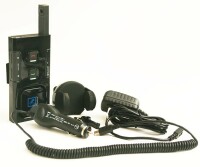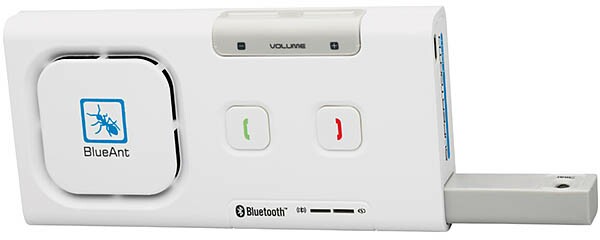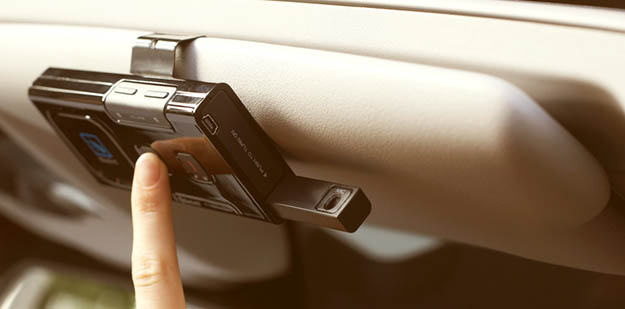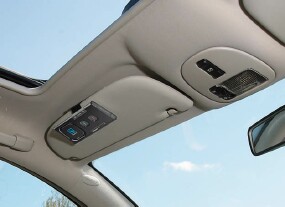
When youre talking on the phone, theres nothing like loud, but that does not apply to noise. Take traffic noise, or coffeehouse chatter, or airplanes taking off. Take them out, and I for one wont miss em. Besides, sound has to be loud to reach the people nodding off in the back of the conference room. You need loudness to reach the back seat drivers in your car pool. But not just loud sound, really. Good, too.
The BlueAnt Supertooth Light Speakerphone delivers both. Loud and good -- that is, as long as were talking about incoming, the kind that eavesdroppers live for. The people on the other end of the call, recipients of the devices outgoing sound, might suffer somewhat, as the audio volume theyre stuck with is lower than an unadorned cell phone normally dishes up.

Im reviewing a black Supertooth Light here, but the sleek device comes in white. The companys brochure shows the product in black on the cover and in some of the promotional pictures, while others are white. Wish I had the white one. I dont know why people insist on making electronic products black. Im not impressed. Give me a nice color, or a choice of colors, or white, or polka-dot panels, even IBM gray, but let go of that black-equals-dramatic product-design crutch.
Usability
Okay, back to the Supertooth Light. Black or white model TreoCentral sells the white one - it snaps magnetically to your cars sun visor and yields impressively loud, noise-canceled incoming audio from your callers. The speakerphone keeps track of up to five paired devices, and if you add another one it automatically bumps the one thats been least used. Nice.
I tested this with two of my five (thats right, five) Treos, my Sprint 700p and my unlocked (crimson!) Treo 680 on SunCom. My 700p now has a successful install of Palms long awaited, much discussed Maintenance Release. The MR fixes issues that the phones had with Bluetooth pairing and such. I previously found it rather frustrating to use Bluetooth devices with the 700p because the smart phone couldnt remember pairings. Im happy to report that this was not the case with the Supertooth Light. It remembered.
Moreover, BlueAnts product behaved as promised. It attempted to pair to my most recently used device my 680 until I turned its Bluetooth off. It then reverted to the 700p without a whimper. Sweet.
Bluetooth pairing, a chore with some products, put no strain at all on my profanity filtration device. It was quite simple. When you first turn the Supertooth Light on, it goes immediately into pairing mode, waiting for you to initiate the pairing conversation from your Treo (Apps > Bluetooth > Setup Devices > Hands-free Setup >). After the first time - for example to pair another device or re-pair the same one after a reset - you can put the Supertooth Light into pairing mode by holding down the speaker phones green-decorated Answer button while turning it on. When its expecting a pairing signal, the LED blinks alternately red and blue. Waiting for a call, the light blinks only blue.
The Supertooth Light uses a spring-loaded, pop-out microphone on a stick to turn the device on and off. Push it in till it clicks, and the device is off. Pop it out, and youre ready to talk. Theres no separate power button. Simple.

After pairing, the Supertooth Light will answer the phone if your Treo is set up to allow the automation (Apps > Prefs > Hands-free > Auto answer and select Immediate, after one or two rings, or Disabled). You can answer a call manually by pushing the answer button (the one with the green symbol on it). The button with the red symbol hangs up or rejects a call.
Of course, you can also perform these answer/disconnect functions by tapping the icons on your Treos screen, if thats more convenient. For me, it usually is, although the Treo need not be accessible to your hand with the speakerphone. It only has to be within Bluetooth range. Nominally thats 10 meters (32.8 feet). For practical purposes out here in the real world, its about four feet, max.
The device knows the difference between short and long presses on the answer button. Hold it down for a half-second or more to redial the last number. The redial transaction isnt entirely informative on the Treos screen, but it works. Voice dial and other features are described in the short-and-sweet manual. This is a great feature. Redialing last number on the Treo isnt as simple.
Power
The Supertooth Light is powered by a Lithium Ion battery that recharges in about three hours from house current with the included cable. A car charging adapter is also included in the kit. The manufacturer boasts 15 hours of talk time on a full charge, almost enough for a twenty-something. Standby time is measured in days instead of hours 33 of them, or 800 hours. You can also recharge by hooking it up with a USB cable to your computer. They dont give you the cable, however. I wish they did, although I found a two-meter USB 2.0 A to Mini-B cable at an online vendor for $3.00 plus shipping, but Ill just borrow the one that came with my digital camera.
Besides talk/dont talk buttons, the only other controls on the device are the volume up/down buttons. These are small electronic switches on the side, covered in a rubbery material. The blue LED winks to let you know the sound volume has been changed. Who knows what the intervals are, but when you reach volume maximum or minimum, the LED glows both blue and red for a second or so. I like the Supertooth IIs volume control better. Its a simple knob.
Sun visor mounting

The back of the Supertooth Light sports two majorly grippy magnets, onto which a supplied steel clip snaps. You mount the clip on your sun visor, and then you can snap the device onto the magnets, inverting it when the sun visors in use for its intended purpose shielding your eyes from glare. Its a clever, effective, and simple mounting method, and the scheme leaves the microphone-on-a-stick near your face, where it has the best chance of picking up your side of a conversation.
The kit also includes an air vent mount that grips the Supertooth Light from the sides. The air vent isnt my mounting place of choice, but the system works, though it doesnt inspire my confidence like the grippy magnets on the sun visor. Maybe your car will be more amenable to the air vent mount, but the real problem is that the Supertooth Lights microphone needs to be near your mouth no more than two feet away, and preferably closer than that. If too distant, the transmitted volume to the caller will be woefully inadequate, as its hardly braggable at its best.
Note: A reader has emailed me that the air vent mount included in this kit is intended for the Treo, not the speakerphone. It fits both. My bad, in the current parlance, but either way, the mount doesn't inspire my confidence. Besides, there are better Treo car mounts on the market.
Supertooth II
Im laboriously spelling out Light every time in this review to avoid confusion with another of the companys products, the Supertooth II Universal Handsfree Kit, which I reviewed in April of last year. Then a CB House product, the II is now in BlueAnts fold. Its a little more expensive, doesnt have quite as good noise cancellation, though what it has is quite good, and its audio performance isnt as clean at higher output volume settings i.e., extra loud. It does have great incoming sound in plentiful quantity, however, and its transmitted (outgoing) sound is higher volume than Supertooth Light, though not as crisp.
Now a word to the wise. Whichever hands-free device you choose, always be careful with it while driving. In some jurisdictions you have to be careful not to get caught talking on the cell phone while driving. In all places, you should be careful not to conduct conversations that distract from the most important thing in your life at that moment: not hitting anything or getting hit.
As for BlueAnts Supertooth Light, its an impressive speakerphone with great audio quality, outstanding noise cancellation, and plenty of volume for incoming calls. Though beautifully filtered for noise and echoes, the devices outgoing sound volume leaves a little to be desired, limiting the devices usefulness for the other-than-the-drivers in a car pool, for example. The easy solution is to speak directly into the microphone from as close as possible, and all is well. This element of the products design could use some work, however.
Blueant has a promotional video on YouTube at this link.
Next Page: Conclusion >>